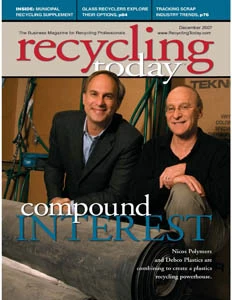During a panel discussion about nonferrous markets held during the Bureau of International Recycling (BIR) Autumn Round-Table Sessions in Warsaw, Poland, a number of attendees expressed concern about the revised European Union waste shipment regulations—particularly the Annex VII "accompanying information" requirements.
Robert Voss of U.K.-based Voss International Ltd., moderator of the session, stressed that enforcement of Annex VII requirements is still "very much in its infancy," but that the effect is likely to be felt "very shortly" in E.U. and non-E.U. countries.
The regulations demand that the Annex VII document accompany trans-boundary shipments of materials designated as "waste," but it was unclear as to how this was to be done, Voss said. Different countries were implementing the requirements in different ways, such that there was "not a level playing field," he added.
Joachim Wuttke, head of Section General Affairs of Waste Management, Focal Point Basel Convention, at Germany’s Federal Environment Agency, said the regulations called for a person "under the jurisdiction of the country of dispatch" to ensure that waste was accompanied by tracking documentation. This phrase has negative implications for many traders, he said, because it suggested their seats of operation must be in the country from which the material is dispatched.
According to U.K.-based legal consultant and commercial lawyer Hilary Stone, the Annex VII requirements confronted exporters of materials termed as "waste" with the potentially stark choice between disclosing confidential, commercially valuable information or risking a criminal record.
Although Annex VII has been introduced under E.U. law, Robin Wiener, president of the U.S.-based Institute of Scrap Recycling Industries Inc. (ISRI), stressed the global implications of its implementation. She expressed particular concern at disclosure of downstream scrap suppliers and the demand for brokers/traders to be under the jurisdiction of an E.U. member nation "in order to buy material from that country and ship it to another." She said she feared once the transition period for enforcement came to an end, the regulations could lead to "penalties or a significant diversion of materials."
BIR Environmental & Technical Director Ross Bartley suggested European Parliament members have not grasped the recycling industry’s concerns about Annex VII, but that associations and companies must press for a re-examination of the issue.
BIR Elects Baxi President of Paper DivisionThe Bureau of International Recycling (BIR), based in Brussels, Belgium, has elected R.S. Baxi as president of its Paper Division.
Baxi is the head of J & H International, a London-based company involved in exporting recovered fiber to Asia. He is also a director of Soulier U.K. Ltd., part of Veolia Environment, a French conglomerate involved in the recycling, refuse collection and water utilities businesses.
Baxi received the Queen's Award for International Trade in 2001.
Stainless Steel Scrap Demand Forecast to Bounce BackDuring a meeting of the BIR Stainless Steel and Special Alloy Committee, held during the recent BIR Autumn Round-table in Warsaw, Poland, in October, several speakers noted that the end of this year will likely result in minimal changes in stainless steel production, especially in Europe and the U.S.
However, according to Michael Wright of ELG Haniel Metals Ltd. and chairman of the committee, demand for stainless steel scrap "will quickly recover in first quarter 2008." Wright added, "We are well past the bottom and are on the increase. When the market comes back, we feel it will come back heavily for stainless steel scrap."
But following the changes made in June to the London Metal Exchange’s lending guidance, nickel prices were unlikely to visit the "unrealistic" $50,000-plus levels of earlier in the year, Wright added. Prices would most likely move between $25,000 to $35,000.
High nickel prices have contributed to an 8 percent decline in the austenitic proportion of world stainless steel production, from 68 percent last year to 60 percent this year. However, in 2008, production of austenitic grades would return broadly to 2006 levels, while growth in other grades would push global stainless steel output from an estimated 28 million metric tons this year to 32.5 million metric tons next year, Wright said.
A possible major expansion of stainless steel production capacity in Russia is in the works. If plans announced by Mechel Group, Jindal Stainless and the Estar Group are realized, Russian production could soar from 127,000 metric tons per year to nearly 900,000 metric tons by 2011, Ildar Neverov of Scrap Market Ltd. said.

Explore the December 2007 Issue
Check out more from this issue and find your next story to read.
Latest from Recycling Today
- Sortera Technologies ‘owning and operating’ aluminum sorting solutions
- IDTechEx sees electric-powered construction equipment growth
- Global steel output recedes in November
- Fitch Ratings sees reasons for steel optimism in 2025
- P+PB adds new board members
- BlueScope, BHP & Rio Tinto select site for electric smelting furnace pilot plant
- Magnomer joins Canada Plastics Pact
- Out of touch with reality





